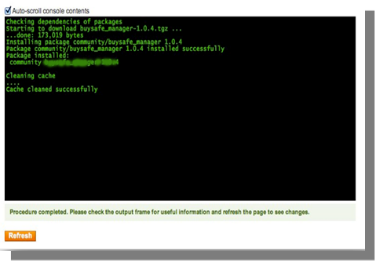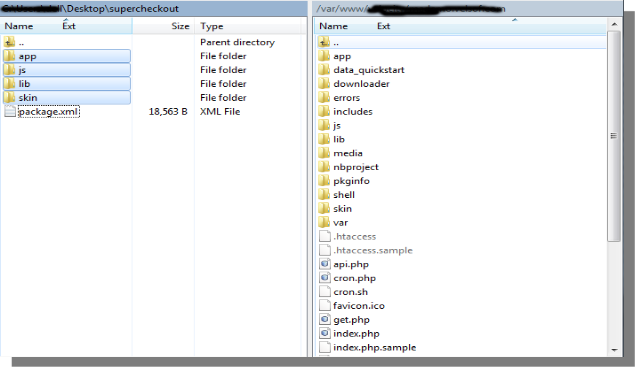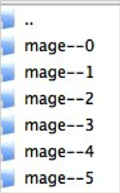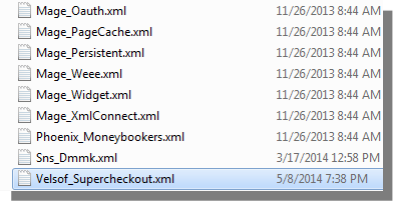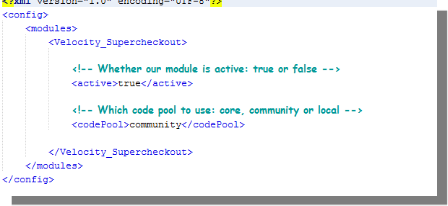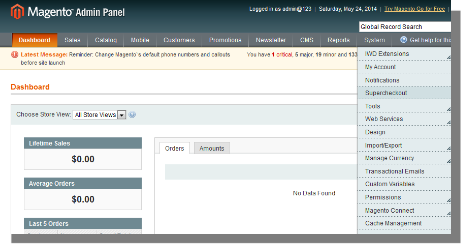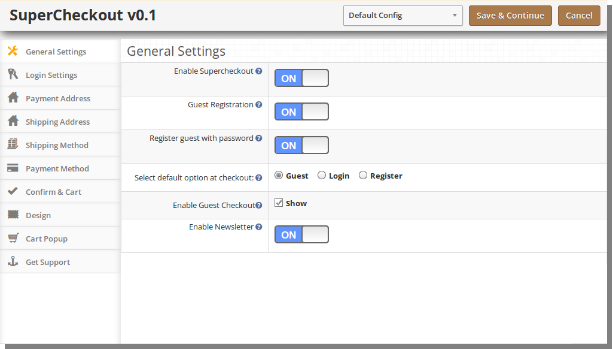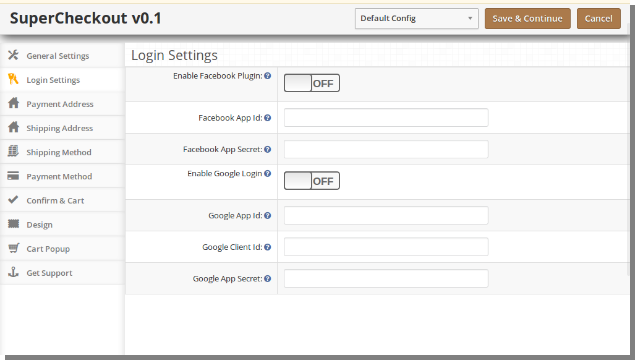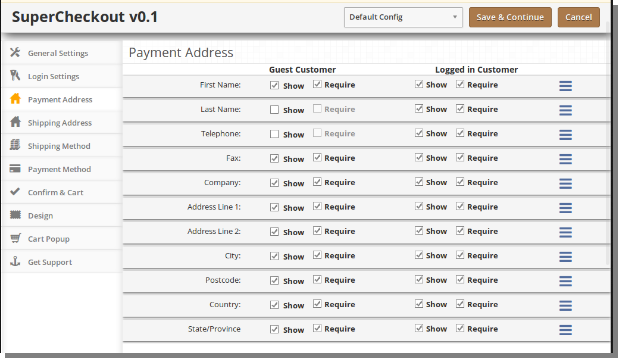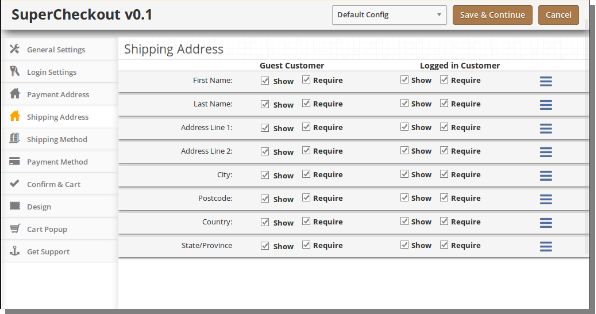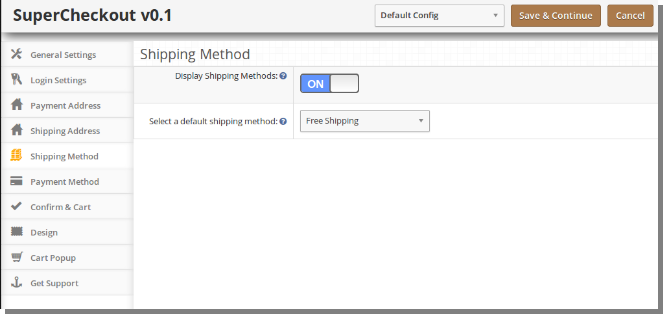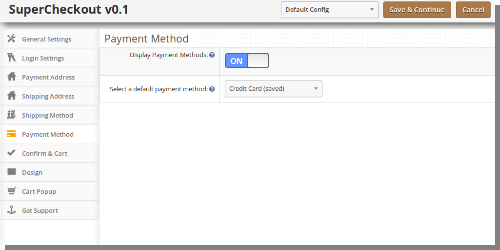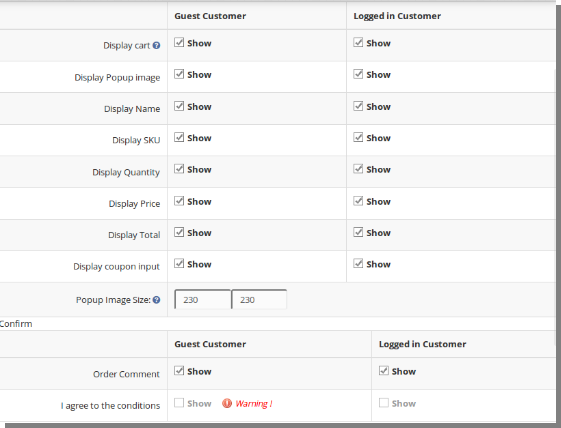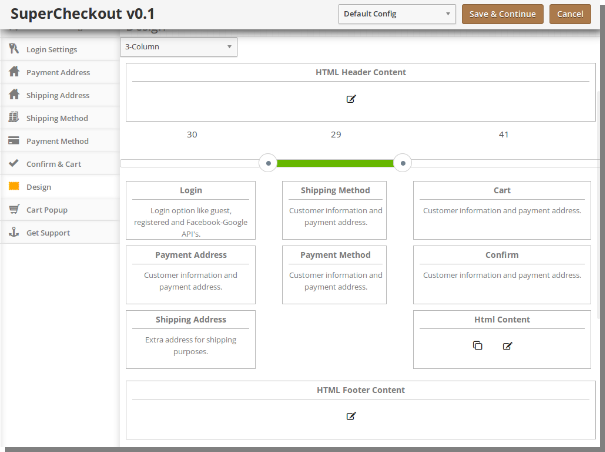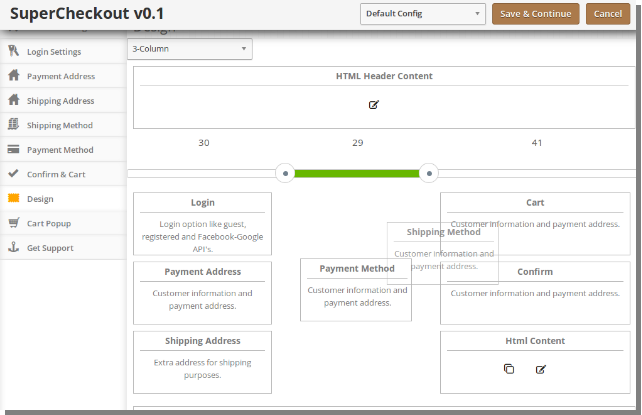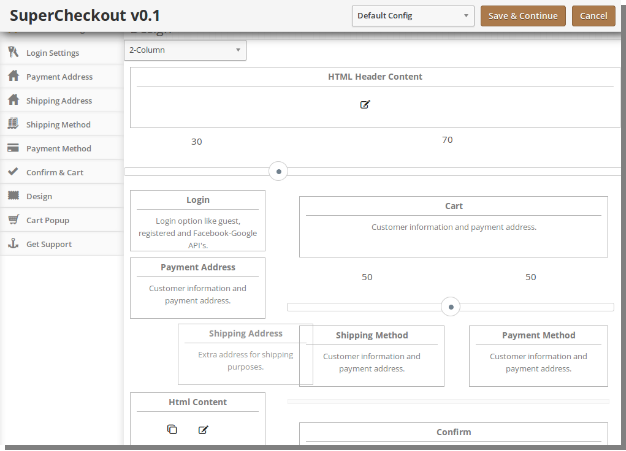Introduction
How to optimize the checkout process for your Magento store to make it responsive yet simple for the online users? By reducing the multiple checkout steps involved in a checkout process of a website, customers are more likely to purchase and thereby increase the conversion rate for your store. To simplify the checkout process of your Magento store, Knowband offers Magento One Page Checkout extension which incorporates a single step checkout page on your website, referred to as Magento Supercheckout. This supercheckout page gathers and displays all the checkout fields on a single page easing customers to fill information and complete checkout for their product.
The checkout page and layout has been optimized to show all necessary steps needed to complete the order on a single page to the customer. Magento one step checkout is fully responsive for desktop, tablet, and mobile views and is perfectly compatible with all native Magento payment and shipping methods which are configurable from the backend interface.
Features of Responsive checkout for Magento
1. Magento one page checkout extension simplifies the multi-step checkout process by incorporating a single step checkout on the store.
2. Ajax based loading of Magento one step checkout eliminates the delayed loading time consumed by multiple checkout pages.
3. Magento quick checkout extension gathers and merges all the checkout field information into a single page checkout form which is convenient to fill for the customers while performing order checkout.
4. The mobile responsive feature of Magento one page supercheckout makes it compatible with all kinds of devices(mobiles or tablets), screen sizes and designs.
5. Store merchant can also enable the guest registration option for their customers which automatically generates and sends a random password to the user for further account use.
6. If guest registration with password is enabled, admin can allow their customers to fill the desired password for their account while performing guest checkout.
7. Magento one page checkout extension offers an option to enable or disable newsletters for the eCommerce store.
8. Magento fast checkout extension offers two easy social login options like Google and Facebook so that the customers can conveniently login and perform checkout on the store.
9. This one step checkout Magento extension offers customizable address fields for payment address and shipping address. Admin can show or hide the fields differently to guest and logged in customers of the store.
10. With Magento one step checkout module, admin can configure and display multiple payment and shipping methods for their shop on the frontend.
11. This Responsive checkout for Magento offers a configurable cart to the store merchants. Admin can show/hide any cart description field as per their site needs.
12. Magento one page checkout extension offers two intuitive and appealing layouts including 2-column and 3-column which are fully customizable from backend panel of the module.
Installation Steps of Magento One Page Checkout Extension
1. Disable the Cache
The Magento front end relies heavily on caching to provide a faster experience to customer. This is a wonderful tool, but can wreak havoc during the installation process. To ensure that the cache is not the cause of any problems, we should turn it off. This can be done from the admin console by navigating to the cache management page (System->Cache Management), selecting all caches, clicking disable from the drop-down menu, and submitting the change.
2. Disable Compilation Mode
This may not be an issue for many readers, but if you are using Magentos compilation mode on your store, it is important that you remove it. Without going into to many details, compilation mode takes many files spread out over the system and condensing them into a single file that can be run very quickly. If an extensions files are not in the system when this single file is compiled, they will not be included. To check that this is disabled, go to System->Tools->Compilation. If the compiler status is Disabled, you are ready to go. If not, simply click the Disable button on the right hand side of the screen.
Choose An Installation Method
There are two different methods used to install extensions.The first involves taking advantage of the Magento Connect Manager, while the second involves manually installing the files via ftp or command line. The first option is generally used by store owners and is a relatively automated process, the problem is that if there is a problem with this process, you are at the mercy of the connect manager to tell you where the problem is coming from. Option two involves getting your hands on the files yourself and manually dropping them into the Magento installation.
Option 1: Using Magento Connect
Required Materials:
- User account for Magento Connect
- Magento Admin account with access to Magento Connect Manager
As stated before, this option is relatively easy to implement. The first step is finding the link on Magento Connect for the extension you wish to install. Once there click install now. If you are not currently logged into the site you will be prompted to do so. Next, select the version of Magento connect you are using (if in doubt, select 2.0), accept the extensions license agreement, and copy the extension key.
Log into your stores admin console and navigate to System->Magento Connect->Magento Connect Manager. At this point you will be prompted to re-enter your administrator credentials. In order to install an extension from the connect manager; you must have an account with full access to the administration console. If you were given limited access, Magento will not allow you to proceed. Once you are logged into the manager, simply paste the extension key into the text box and click install. A system window will appear towards the bottom of the page that will display the progress of your installation.
Congratulations, you have successfully installed the extension on your store. Be sure to test thoroughly before re-enabling the cache/compilation. If you found no problems both before and after these features have been re-enabled, you should be ready to repeat the installation process on your live site. DONT FORGET TO BACKUP ALL FILES AND DATABASES BEFORE INSTALLATION!
Option 2: Manual Installation
Required Materials:
- All files used by the extension.
- FTP access to your website.
The connect manager is a useful tool for installing extensions, but prefer hands-on method when it comes to installations. It feels more comfortable when you are personally in control of the process.
Do you see an app-code directory there, what about app-etc-modules? If you dont see these directory paths and files contained within them chances are that the extension download was faulty. Take a look at the package.xml file, this is the blueprint used by Magento Connect to arrange the files in the proper places. You may need to use this to ensure that everything is as it should be. Once you have reviewed the extension files you are ready to perform the last step. Using your ftp client, drag all of the files onto the store root of the Magento instance. Depending on the number of files in the extension, this may take a few moments.
Now go to the admin console and click Flush Cache Storage. This is the requirement for any extension that adds pages to the admin console. Logging out and back in is also required to ensure that everything loads properly. If you cannot clear the cache via the admin console for any reason, you will need to clear the cache manually via your FTP client (see the first FAQ question for assistance). That is the final step. Congratulations on a successful installation.
Troubleshooting & FAQs
I loaded all files onto my Magento store, and now get a white screen for some or all of the admin console.
This is a fairly common problem, and 99% of the time it is cache related. If you can get to it, go to System->Cache Management and click Flush Cache Storage. This will ensure that everything cached by Magento is deleted and will to be regenerated. Log out and back in to complete the process.
If you are completely cut off from the admin console, navigate to the var-cache directory of your website. You should see a series of directories named mage*. Delete all of these directories (DO NOT DELETE var-cache). This is the equivalent of flushing the cache storage from the admin console.
I am receiving a Magento error when accessing certain pages. How can I debug this?
This question really deserves a blog post all to itself, but a good start would be to go into the errors directory of your store. Locate the local.xml.sample file and rename it local.xml. The next time you see the error detailed information will be provided explaining where the error took place. Dont forget to change this back when you are finished troubleshooting!
I have a critical error with my webstore and need to turn off an extension I cannot access the admin console. What do I do?
Go to the app-etc-modules directory and open the file that goes with your extension. The naming convention is generally DeveloperName_ExtensionName.xml. In this case it would be Velsof_Supercheckout.xml.
Look for the active tags in the file, change the value from true to false and save your changes. This tells Magento that the extension is disabled and not to run any code associated to it. Deleting the Magento cache is recommended (and most likely required) for this change to take effect.
General Settings
- To excess Super Checkout plugin, Click on supercheckout option appearing as a sub menu in navigation menu under System main menu as shown below.
- On clicking sub menu Supercheckout the module for plugin will open. It contains navigational bar at the top, menu at the left and main content in the center as shown below. To enable the plugin, switch the enable button from OFF to ON which is just to the right of Enable/Disable label.
- To enable guest registration, switch the button from OFF to ON which is just to the right of Register Guest Automatically label. Enabling this would result in registering the guest to your store and an automatically generated password would be mailed to that user.
- To enable registration, switch the button from OFF to ON which is just to the right of Register Guest With Password label. On enabling this password and confirm password fields will appear so that customer can register from the checkout page itself.
- To change the default option from Guest, Login or Register in Login section of checkout page, select an option from given radio button. The selected option will be set as chosen option by default.
- To enable or disable guest checkout by the user check/uncheck the checkbox which is just to the right of Display Guest label.
Login Tab
- This tab of Magento One Page Checkout basically contains setting to enable /disable Facebook and Google registration & login as shown below.
- To enable Facebook Registration & Login switch the button from OFF to ON which is just to the right of Enable Facebook Login label. But before you do that do get facebook APP ID and APP SECRET from https://developers.facebook.com.
- Enter the APP ID and APP SECRET in their respective fields and save. You will find Facebook login button on your checkout page.
- To enable Google Registration & Login switch the button from OFF to ON which is just to the right of Enable Google Login label. But before you do that do get Google APP ID, CLIENT ID and APP SECRET from https://code.google.com/apis/console. For detailed instructions to get the APP ID, download the Facebook & Google Setup guide from oepncart accout.
- Enter the APP ID, CLIENT ID and APP SECRET in their respective fields and save. You will find Google login button on your checkout page.
Payment Address Tab
- This tab of Magento One Page Checkout contains setting for the fields which is to be shown in Payment or Billing Address section in checkout page as shown below.
- It consists of two sections. The one in the left is for Guest Customers and the right one for registered customers.
- To make a field display/hide in the checkout page check the checkbox just to the left of Show label.
- To make a field as mandatory (required field) check the checkbox just to the left of Require Label.
- The fields can also be rearranged according to the requirement. To rearrange just move the cursor to the drag icon and drag & drop the field wherever it is required as shown below.
- On saving, the fields will be rearranged as per the changes.
Shipping Address Tab
- This tab of Magento One Page Checkout contains setting for the fields which is to be shown in Shipping Address section in checkout page as shown below.
- It consists of two sections. The one in the left if for Guest Customers and the right one for registered customers.
- To make a field display/hide in the checkout page check the checkbox just to the left of Show label.
- To make a field as mandatory (required field) check the checkbox just to the left of Require Label.
- The fields can also be rearranged according to the requirement. To rearrange just move the cursor to the drag icon and drag & drop the field wherever it is required which is same as payment address.
Shipping Method Tab
- This tab of Magento One Page Checkout contains settings for shipping method which is shown in checkout page. It basically contains settings for enabling/disabling and setting the default shipping method as shown below:
- To Enable/Disable the shipping methods from the checkout page switch the button from ON to OFF or vice-versa. This will disable the shipping method block from checkout page. But you should select a default shipping method (if any installed) to apply shipping charges to the order.
- To get a default shipping method selected in the checkout page select the default shipping method from the dropdown. If the selected shipping method is not installed it will automatically select from installed shipping method.
Payment Method Tab
- This tab of Magento One Page Checkout contains settings for payment methods shown in checkout page like enabling/disabling or selecting a default method.
- To Enable/Disable the payment methods from the checkout page switch the button from ON to OFF or vice-versa. This will disable the payment method block from checkout page. But you should select a default payment method (if any installed) to get a payment method in the checkout page.
Confirm Tab
This tab contains setting of Magento One Page Checkout is for the cart and confirming the order as shown below:
- Its divide in two section
a. Cart
b. Confirm
Cart
1. This tab is again divided into two sections, the left one is for Guest Customers and Right one for Registered or Logged in customers.
2. To Display/Hide cart from the checkout page check uncheck the checkbox present in front of Display Cart label.
3. To enable/ disable any column in the cart check/uncheck the checkbox in front of that respective column.
4. To enable/disable the popup images for the product check/uncheck the checkbox in front of that respective column.
5. To change the size of popup for images Enter the width and height of the popup in textbox in front of Pop Image Size label.
6. Coupon and Voucher options can also be disabled or enable by checking/unchecking the checkbox in front of that respective field.
Confirm
1. This tab is again divided into two sections, the left one is for Guest Customers and Right one for Registered or Logged in customers.
2. To enable the comment box for the order by customer check the checkbox in front of that Leave a comment for the order label & to disable uncheck the same checkbox.
3. To enable agree to the term or any other information saved in the admin for the store check/uncheck the checkbox in front of I agree to the conditions label.
Design Tab
- This tab contains the settings for the design of checkout page in the catalog as shown below
- To change the width of any column adjust the slider present at the top as shown below :
- Block of different steps can also be rearranged from one column to the other or in the same column as shown below:
- On saving, the block will be rearranged in the checkout page as per the changes
- The same goes for layout with two columns as shown below:
Confirm and Cart Tab
- This tab contains the settings for pop up cart that appear on adding any product to the cart.
- To enable the popup cart on frontend, you can show/hide the complete cart or you can show/hide the selected cart fields only.
- Admin can select and unselect the different cart fields for logged in and guest users of the store.
- Admin can also set the Popup Image Size which is shown over the product shown in the cart section of the checkout.
- Store merchants can also grab cutomer’s comment regarding the product by enabling and disabling the order comment field on supercheckout page.
Visit Magento One Page Supercheckout extension product page
You Might Also Like:
- Why do you need a One page Magento Checkout Extension?
- Beginning of a new era of easy checkout process with the emergence of Magento One Page Supercheckout Lite Module
- Enjoy A New Online Shopping Experience With This Magento One Page Supercheckout Extension
- Forget all checkout related worries with this Magento One Page Supercheckout Plugin
- How can One Page checkout improve your checkout process?




